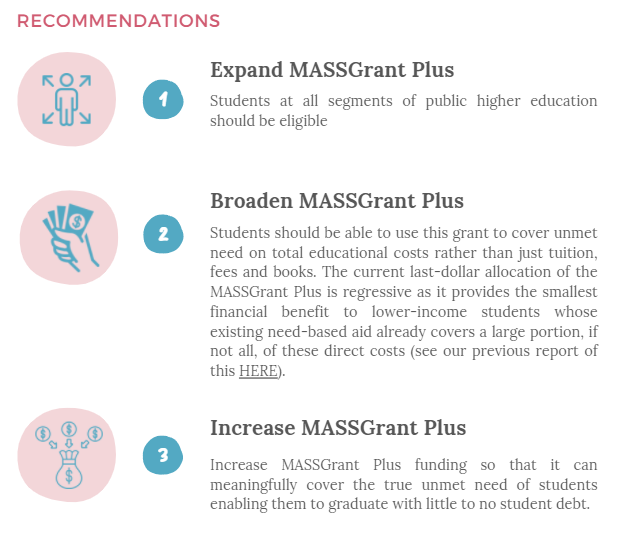Massachusetts Higher Ed:
Underfunded Unaffordable and Unfair
APRIL 2022
Executive Summary
In 2020, the average state aid a student received covered a meager four percent of their tuition and fees – making this aid no longer a factor for most low-to-middle-income families. MASSGrant, the state’s primary need-based grant for students, used to cover 80 percent of a student’s tuition and fees at a state school. Now it covers just 10 percent for those most in need of financial assistance.
With limited financial aid support and annual increases in tuition and fees, low-to-moderate-income students are forced to choose between balancing a heavy work schedule with their courses or taking out student loans to cover their unmet financial need. The average low-to-middle-income student is shouldering $10,000 in unmet need each academic year.
This debt often proves to be too burdensome for many low-to-middle-income families, especially those in communities of color – further exacerbating barriers people of color already face in higher education and in the workforce. In communities of color, only 36 percent of people have a college degree – while those rates reach 50 percent in predominantly white communities.
What has long been considered a critical step toward social and economic mobility in this nation is being held out of reach for Latino and Black and African-American families in Massachusetts, with many being forced to abandon the hope of a college degree for themselves and their children. High debt-burdened low-and-middle-income students who are able to graduate are at a significant disadvantage upon graduation – with hefty loan payments draining their resources, further exacerbating existing economic and racial disparities.
Key Findings:
More students at public colleges and universities take out loans than those at private, not-for-profit schools in Massachusetts
63% of students at public universities have to take out loans
53% of students at private, non-profit universities have to take out loans
Students attending state schools are graduating with more debt than their peers at private universities:
$24,112 – average student debt at graduation (at a four-year public university)
$23,940 – average student debt at graduation (at a four-year private university)
All of these burdens are leading to negative enrollment trends that further disenfranchised communities most in need of support and investment:
6.9% drop in undergraduate enrollment at all state public colleges and universities in 2020, followed by a 4.2% drop in 2021
Community colleges saw the sharpest rates of declining enrollment – especially among first-year Black and Latino students: seeing a 33% enrollment drop between 2019 and 2020
40% of the total revenue of our four-year public universities comes from tuition and fees because they are unable to rely on adequate state funding
Low-and-middle-income students facing unmet college costs are forced to work more than 10-15 hours/week, putting them more at risk of not graduating on-time or at all
Recommendations
These findings point to unmet financial need as the main culprit for persistent achievement gaps.




